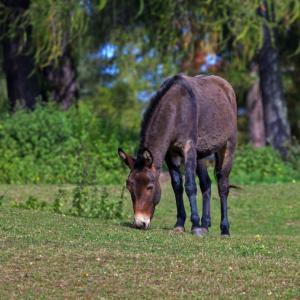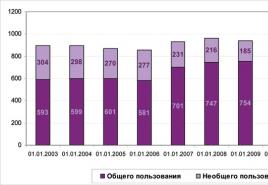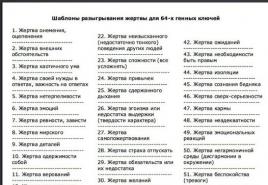How to protect your body from xenobiotics. What are xenobiotics and how are they destroyed
Medicinal substances and industrial pollution, pesticides and household chemicals, food additives and preservatives - this is the stream of alien compounds that with increasing force falls on our planet and the organisms living on it.
These synthetic components are added to a huge variety of naturally occurring foreign substances that are formed by plants, fungi, bacteria and other organisms. It is not without reason that these compounds are called "xenobiotics", that is, "alien life".
In such an acute situation, all living things would have long been under the threat of death if it did not possess mechanisms that tirelessly maintain their "chemical purity". Organisms of higher animals and humans, in response to the introduction of antigens, form antibodies and thereby neutralize their effect on the body. However, antigenic properties, i.e., the ability to induce the formation of antibodies, are possessed only by high molecular weight xenobiotics - proteins, glycoproteins, some polysaccharides and nucleic acids. But how are low molecular weight xenobiotics neutralized? Studies have shown that this function is performed by the cytochrome P-450 oxygenase system present in the mammalian liver.
No wonder they talk about the "barrier" role of the liver, which is a kind of filter that cleans the body of harmful substances. With the help of this enzyme system, many non-polar, poisonous for the body, and therefore water-insoluble compounds - medicinal substances, drugs, etc., are converted and thereby neutralized. The task of this system is to convert insoluble compounds into water-soluble compounds so that they can be removed from the body.
Cytochrome P-450 is found in many animals, plants and bacteria. It is not present in anaerobic bacteria living in anoxic conditions.
AI Archakov calls cytochrome P-450 "membrane immunoglobulin". The latter is located in the membranes of the endoplasmic reticulum. By 4980, at least 20 forms of cytochrome P-450 were known. The plurality of forms is characteristic precisely of higher organisms, while bacteria contain only one type of cytochrome P-450.
Existence plural formsprobably explains the broad substrate specificity of the oxygenase system, which can oxidize a wide variety of molecules. It is assumed that in response to the introduction of a certain class of xenobiotics into the body, a certain group of cytochrome P-450 is synthesized, just as in response to the introduction of a macromolecular antigen, strictly complementary antibodies to it arise.
Thus, there are two systems of immunological surveillance in mammals. The first of them is the lymphoid system, which destroys cells and high molecular weight compounds, the second is the monooxygenase system, which detoxifies xenobiotics. If the first immune system protects the body from foreign macromolecules, then the second - from foreign low molecular weight substances. It is assumed that sometimes both immunological systems act in combination. After oxidation by the oxygenase system of the xenobiotic, its oxidized form binds to a specific protein. The resulting conjugate acquires antigenic properties and begins to cause the formation of antibodies. The role of conjugase is again played by cytochrome P-450. It turns out that a xenobiotic, getting into an animal's organism, induces not only its oxidation, but also the biosynthesis of the corresponding antibodies.
With the help of the oxygenase system, not only exogenous xenobiotics are oxidized, but also a number of endogenous (internal) ones formed in the body: steroid hormones, fatty acids, prostaglandins, etc.
In the liver of mammals, there is another system that helps them remove xenobiotics from the body. This is the addition, or conjugation, to various kinds of drugs, poisons, drugs and other glutathione compounds, as a result of which xenobiotics are rendered harmless and then excreted from the body.
However, there are misfires in the operation of neutralization systems. There are cases when these systems, trying to neutralize some toxic substance, turn it into a carcinogen, that is, into a compound capable of causing a malignant tumor.
Everything that has been said refers to the systems for neutralizing xenobiotics in mammals, where these processes have been intensively studied and continue to be studied. But what about plants? The question is far from idle, since it is the plants that have to basically take on the endless stream of foreign substances that man himself and the industry created by him bring down on their surface. Unfortunately, if such studies were conducted, then in extremely limited numbers. And the information that we have at our disposal mainly relates to the ability of plant tissues to convert herbicides (mainly 2,4-dichloropheiolacetic acid), as well as some insecticides. Even the famous DDT in this respect still remains almost unexplored; moreover, there is an opinion that plants are not able to metabolize it.
However, the limited information available in the literature allows us to conclude that plants also have xenobiotic detoxification systems that resemble in their properties the oxygenase system of mammalian liver microsomes. In the composition of plants belonging to 20 species, cytochrome P-450 was found, the spectral characteristics of which are surprisingly similar to the spectra of the corresponding cytochromes from the mammalian liver. In microsomes of more than 20 plant species, the presence of oxygenase activity was found, capable of converting a number of xenobiotics. This enzyme system depends on the presence of a lipid cofactor and is suppressed by the same inhibitors as oxygenases from liver microsomes. Plants also have a number of enzymes responsible for attaching glutathione to herbicides. It is believed that such a detoxification mechanism may explain the insensitivity of some plants to herbicides.
Obtaining direct evidence of the involvement of the monooxygenase system in the ability of plants to detoxify exogenous and endogenous xenobiotics and thereby maintain their chemical homeostasis requires more attention from phytoimmunologists than has been paid to it so far. It is possible that the results of these studies will show that plants on our planet function not only as “green lungs”, producing oxygen in the process of photosynthesis, but also as a “green liver” that metabolizes xenobiotics and protects the biosphere from pollution.
Since childhood, many of us are familiar with the series about the invincible warrior, Princess Xena (Xena), who fights against the forces of evil. Did you know that "Xena" in translation from Greek means "alien"?
In addition to the warlike princess, a family of harmful substances alien to the body bears the same name.
Meet the xenobiotics!
Xenobiotics are antibiotics, pesticides, herbicides, synthetic dyes, detergents, hormones and others chemical compounds... They are found in soil, water, food, air. These substances alien to our body, getting into the body, undermine the immune system and become the cause of and. Unfortunately, it is simply unrealistic to completely isolate oneself from their harmful influence today.
Xenobiotics cause disruption of the work of many organs, and, as a consequence, cause diseases of the digestive system, respiration, cardiovascular system, and kidneys. With prolonged exposure to humans, xenobiotics become the cause of malignant tumors.
Mother Nature has provided mechanisms for protection from strangers. They are destroyed by cells of the immune system, liver, there are even cellular barriers for various toxic substances.
And humanity, who invented these xenobiotics, also came up with intestinal sorbents (Enterosgel). Thanks to enterosorbents, “harmful” molecules are absorbed and, ensuring full functioning of the liver, protecting cells from harmful factors.
In order for the protection to be strong, the body needs helpers - nutrients. Who could it be?
Vitamins
Vitamins protect immune cells from damage.
The main sources of vitamins are vegetables, fruits, cereals, seaweed, green tea.
Minerals
Microelements are responsible for immunity: selenium, magnesium and zinc.
These minerals are found in cereals, legumes, seafood, liver, and eggs.
Cholesterol and phospholipids
These substances are "building blocks" for cell membranes, in particular - liver cells. Sufficient intake of these phospholipids with food ensures the "resistance" of liver cells to "outsiders". Fatty acids, choline, "good" cholesterol are found in sea fish, nuts, yolks, and flax seeds.
Protein
Liver function is directly related to what we eat every day. With insufficient consumption of protein foods, the activity of the liver decreases.
Where does the body get the proteins it needs?
In nuts, greens, legumes, eggs, poultry, river and sea fish, low-fat cheese, milk.
Cellulose
When starting the fight against xenobiotics, we must not forget about the benefits of dietary fiber. They, like Enterosgel, retain a large amount of toxins and carcinogens on their surface.
Dietary fibers (fiber) are rich in fruit and vegetable purees, marmalade, oat and wheat bran, seaweed.
Phytoncides
Everyone knows the benefits of phytoncides. They are always talked about a lot during the fight against influenza and other viral infections. Most of the phytoncides are found in onions and garlic. Rich in phytoncides:
Carrots, horseradish, tomato, bell pepper, Antonovka apples,.
Berries: blueberries, blackberries, dogwood, viburnum;
Ginger, turmeric.
Harmful products: list
A considerable part of xenobiotics enters the body "thanks" to our culinary preferences. In order not to expose ourselves to unjustified risks, let's give up junk food!
So, on the black list:
sausages, sausages, smoked meats;
margarine, mayonnaise, vinegar;
confectionery and sweet carbonated drinks;
Does this mean that they should be excluded from the diet? Your health, so "think for yourself, decide for yourself!"
Unfortunately, it is not always possible to avoid products from the “firing squad” list - it is for such cases that there is enterosorbent No. 1 - Enterosgel! This drug, created by order of the USSR Ministry of Defense, helps to effectively and for health fight against poisoning, allergies, harmful food additives, and even.
| Parameter name | Value |
| Topic of the article: | Protection of the body against the penetration of xenobiotics |
| Category (thematic category) | Production |
Xenobiotics - the general name of all substances foreign to the body inanimate nature... Protection system, has 3 basic levels:
1) barrier - skin, structural features of the upper respiratory tract, selective permeability of epithelial cells lining the inner surface of the body's pathways;
2) enzymatic - enzymes of cells of various tissues, enzymes of the digestive tract can transform xenobiotics that have penetrated into the body into compounds such as organic bases or organic acids;
3) Transport - is represented by special cells of various tissues that have a carrier protein in their structure. It is able to bind with organic bases or acids and transport them into or out of the cell. Through the conveyor of such cells, xenobiotics transformed by enzymes are carried into the blood and attached to erythrocytes. Erythrocytes carry them to the liver and there they are released from them.
The defense system has been formed during the biological evolution of animals and humans over millions of years and is highly effective against natural xenobiotics. The development of production led to the accumulation and emergence of new chemical substancesthat overcome the barriers of the body. Many, due to their chemical properties, destroy them, creating conditions for the penetration of natural xenobiotics and opening new gates for infections, which increases the possibility of developing infections and allergic diseases. The enzyme system of the body is limited by hereditary information and, therefore, it does not include enzymes that can transform most industrial xenobiotics. The transport system is initially capable of removing from the body only certain groups of chemical compounds and is closely related to the efficiency of the enzyme system. For this reason, many modern xenobiotics penetrate into the internal environment of the body, are not removed from it and accumulate in certain tissues called depots (most often adipose tissue). Penetration of xenobiotics into the body can lead to acute or chronic poisoning, provoke carcinogenesis, allergies, and increase the frequency of mutations.
12.7 Control system of individuality and integrity of the body (Immune system)
As is known, the hereditary information of an organism is reduced to information about the structure of its proteins, that is, all proteins of the organism are synthesized on the basis of its individual information. The system for controlling the individuality and integrity of the body is usually called the immune system. The reactions of the immune system to recognize, neutralize and eliminate foreign protein compounds from the body are called immunity. The ability to induce immune reactions upon penetration into the body is commonly called immunogenicity. Only proteins, their compounds and large carbohydrates have immunogenicity. At the same time, when a chemical complex of a non-immunogenic substance, for example, a drug with a protein, enters the body, the immune reaction will also develop, and the products of this reaction will interact with the entire complex, and only with the protein, and only with a non-immunogenic substance. included in the complex. That is, if, due to accidental circumstances or improper use of drugs, its complex is formed with its own or any other protein, then after a while, the products of the body's immune reactions will be produced when only drugs are received. Τᴀᴋᴎᴍ ᴏϬᴩᴀᴈᴏᴍ, an immune (allergic) reaction develops to any non-immunogenic substances. Protein compounds that cause immune reactions upon penetration into the body and are able to interact with the products of these reactions are called antigens.
Immune reactions are divided into 2 groups:
Non-specific - these are such reactions, the products of which are constantly produced in the body, are constantly present in it and are able to neutralize large groups of possible antigens. First of all, they include phagocytes - cells of the immune system circulating in the blood or present in various organs, capable of absorbing particles of antigens, digesting them, splitting them into harmless substances that are removed from the body. Non-specific products of the immune system include complement. Complement is a serum enzyme system that breaks down foreign soluble antigens. The possibilities of both phagocytosis and complement are limited, because they neutralize only antigens with certain common properties. For example, the presence in the chemical structure of a certain chemical group. Antigens lacking these general properties, the products of nonspecific reactions will not be neutralized.
Specific immune responses - these are such reactions, the products of which are produced only in response to the penetration of an antigen and can interact only with this antigen. The main product of specific immune responses is antibodies (At) or immunoglobins (Ig). Immunoglobulins - ϶ᴛᴏ blood serum proteins produced by cells of the immune system in response to the penetration of an antigen, in the molecule of which there is a site that can interact only with this antigen. When an immunoglobulin interacts with an antigen, a complex is formed - "antigen-antibody", which can:
and ) attach to erythrocytes and together with them, entering the liver, then excreted from the body;
b) destroyed by phagocytes or complement, regardless of the initial properties of the antigen;
Given the dependence on the form of antigen neutralization, immunoglobulins are divided into classes: IgA, IgM, IgG, IgE. The main difference between specific immune reactions and all other protective reactions of the body is that not certain products are genetically programmed to neutralize certain antigens, but the ability to produce antibodies in response to the penetration of any antigen, which can neutralize only this antigen. Due to this, the possibilities of specific immune responses are endless and provide a protective response against any probable infectious agent. Moreover, since they develop only after the penetration of the antigen into the body and their development takes time, the causative agent of the infection manages to multiply in the body, destroying it, which leads to the disease. Sometimes the rate of reproduction and the destructive effect of the pathogen have time to make the body unviable until the full development of protective reactions. At the same time, after recovery, cells of "immunological memory" remain in the body, which, with the second penetration of the same antigen, will lead to a very rapid accumulation of the necessary antibodies, and the disease may not exist at all or it will pass in a mild form.
Immunodeficiencies -disturbances in the functioning of the immune system, leading to a lack or complete absence of products of certain immune reactions.
Primary immunodeficiencies -due to heredity. These include several rare hereditary diseases and physiological immunodeficiency in newborns. Since the formation of the immune system is not completed by the time of birth, the amount of antibodies produced in the body of a child under 13 is 1000-10 times less than that of an adult.
Secondary immunodeficiencies -develop as a result of the interaction of the body with the environment. Main reasons:
1) any injury causes a temporary immunodeficiency in proportion to the severity of the injury.
2) psychotropic substances that suppress the central nervous system. Any operation under general anesthesia causes immunodeficiency for 2.5 months.
3) insufficient protein nutrition or a violation of protein metabolism.
4) any stress.
6) components of transport and production emissions suppress immune responses.
The widespread occurrence of all of these factors in the environment modern man led to the fact that, according to the WHO, up to 80% of the world's population constantly or periodically has some form of immunodeficiency, which is the main factor in the spread of HIV infection.
HIV (Human Immunodeficiency Virus) is the only infection that is not accompanied by immunodeficiency, but causes it. HIV infects T-lymphocytes - helpers (Th), whose main role in the recognition of their own and foreign antigens, without their signal, antibodies do not begin to be produced. After infection of a cell, the virus remains inactive for an unpredictable long time: it does not multiply and does not destroy infected cells. But such a cell synthesizes some viral proteins, and since the immune system is still working normally during this period, these viral proteins are recognized as foreign antigens and antibodies are produced on them. The presence of antibodies in the blood serum is used to diagnose latent HIV-carriage.
When the virus activates, the infected cells form many new viruses. Οʜᴎ leave the cell, destroying it, and immediately infect and destroy others. Since, due to the mass death of Th, the immune system ceases to recognize foreign antigens, the production of antibodies for the entire infection stops. AIDS develops, in which a person falls ill with many infectious diseases at once, and his life is supported only by a complex of modern antibiotics that inhibit the reproduction of pathogens.
HIV transmission occurs through sexual contact or when the virus enters the bloodstream. At the same time, penetration of the virus into the blood does not always lead to infection. In 1999, out of 2003 people (workers of research institutions, to whom the virus was guaranteed to get into the blood as a result of the accident), only 5 people were infected. Studies have shown that infection of the body through the blood is possible if the immune system is in a state of immunodeficiency. This explains the high percentage of sexually transmitted infections. the genital tract is maximally isolated from the action of the products of immune reactions. A large% of infection in medical institutions is explained by the fact that stress as a result of illness, surgery, and various drugs suppress the immune system. The widespread spread of HIV among drug addicts is also explained by the immunodeficiency caused by constant drug use.
Protection of the body from the penetration of xenobiotics - concept and types. Classification and features of the category "Protection of the body against the penetration of xenobiotics" 2017, 2018.
8085 0
Xenobiotics pollute all natural environments - air, water bodies, soil and flora. Industrial waste and other pollutants natural environment have the ability to quickly spread in air and water, being included in the cycle of nature. These toxic compounds accumulate in water bodies and soil, sometimes in places far from sources of infection, which is facilitated by wind, rain, snow, as well as the migration of pollutants by water (seas, rivers, lakes). From the soil, they enter plants and animals.
The central place in the cycle of xenobiotics in the biosphere is occupied by soil. It is in constant interaction with other ecological systems, such as the atmosphere, hydrosphere, flora, and is an important link in the entry of various components, including poisonous ones, into the human body. This happens primarily through food. All living things need food as a source of energy, building materials and nutrients that ensure the vital activity of the body. However, if it contains not only useful but also harmful substances, it becomes dangerous. Xenobiotics are the cause of disease and death of plants and animals. Xenobiotics that are resistant to the environment and capable of accumulating in it acquire a particular danger.
The prevalence of xenobiotics in the environment depends on climatic and meteorological conditions and the nature of water bodies. Thus, high air humidity, wind direction, precipitation (rain, snow) contribute to the prevalence and loss of xenobiotics. Fresh water bodies, seas and oceans differ in the degree of accumulation of xenobiotics. The type of soil, different plants and their constituent parts also differ in the degree of absorption and retention of xenobiotics. And different animals have different sensitivity to xenobiotics. The degree of accumulation of xenobiotics in the body of animals is due to the persistence of these foreign substances.
So, Canadian researchers showed that the water of Lake Michigan contained only 0.001 mg of the pesticide DDT in 1 liter, while shrimp meat contained 0.4 mg / l, fish oil - 3.5 mg / l, and the fat of seagulls that ate fish from this lake - 100 mg / l. Consequently, in each subsequent link in the food chain, there is a gradual increase in the concentration of persistent pesticide DDT, with the lowest content of this substance noted in the lake water. Therefore, it is not surprising that organochlorine pesticides are found not only in the fat of marine fish and farm animals, but even in the penguins living in Antarctica.
A person should always remember that his activity in one point of the planet can cause unexpected consequences in another point. For example, a petrel seems to live on uninhabited rocks in Atlantic Ocean and feeds exclusively on fish. However, it is becoming an endangered species due to DDT used on land, which accumulates in marine food webs. Another example would be polar icewhich contain a significant residual amount of DDT carried by atmospheric precipitation.
Properties of xenobiotics coming from the external environment into the human body:
- the ability of xenobiotics to spread in our environment far beyond their original location (rivers, winds, rain, snow, etc.);
- environmental pollution is very persistent;
- despite the wide difference in chemical structure, xenobiotics have certain common physical propertiesthat increase their potential danger to humans;
- combinations of various xenobiotics are especially dangerous for human health;
- xenobiotics are characterized by a low intensity of exchange and removal, as a result of which they accumulate in the tissues of plants and animals;
- the toxicity of xenobiotics for higher mammals is usually higher than for animal species of a lower phylogenetic order;
- the ability of xenobiotics to accumulate in food;
- xenobiotics reduce the nutritional value of foods.
In the course of evolution on Earth, relationships developed in such a way that some organisms served as food for others, and thus stable food chains were established. As a result, a person has become the main final link in numerous food paths and can be included in these food chains at almost any level. And this is not surprising, since life from its inception has formed as a chain process. The prosperity of any organism is largely determined by its position in the food chain, and this is ensured by the effectiveness of interactions not only with the previous, but also subsequent members of the food chain. In other words, an essential role is played not only by the source of nutrition and its effective absorption, but also by the eatability of this member of the ecological system by others.
Migration paths, i.e. food pathways along which nutrients move are diverse, including short and long ones. An example of a long food chain: bodies of water - soil - plants - animals - food - people. An example of a short food chain: water bodies - aquatic organisms - fish - humans.
Formed in nature organic matter They migrate along food chains in various ecological systems (atmospheric air, water bodies, soil) and enter the human body in the form of food products of plant and animal origin. However, food contains not only our friends, but also enemies, since at the same time numerous nonfood, foreign substances generated by the chemicalization of industry and agriculture move along the food chains and are toxic to humans and other living beings. Therefore, it is no coincidence that many scientists talk about poisons in our food. Recently, many scientists also talk about the protection of the internal environment of the human body.
Academician Pokrovsky says: “We are deeply convinced that an important integral criterion for food protection measures aimed at preventing diseases should be indicators of the chemical purity of the internal environment of the human body, from freedom from foreign, especially persistent substances. It should be recognized that the accumulation of any persistent foreign substance in the internal media of the body is extremely undesirable, and in some cases dangerous. " This concept provides for quite obvious measures aimed at reducing the levels of pollution by toxic substances in all, including food, objects of the external environment. Thus, the purity of the environment is a necessary prerequisite for the purity of the internal environment of the human body.
Xenobiotics have a negative effect on nutrients (proteins, carbohydrates, fats, vitamins, mineral salts), thereby reducing the nutritional value of food.
It should be borne in mind that xenobiotic contamination of food products is possible not only during their receipt, but also during storage, processing, transportation and sale to the population. Environmental pollution is quite stable with a tendency to spread, accumulate in food chains, and can undergo biotransformation with an increase in toxicity. The severity of the resulting effects varies widely depending on the degree and duration of exposure to xenobiotics. A number of xenobiotics are able to accumulate in the human body and, therefore, have a long-term harmful effect.
The negative effect of the action of xenobiotics on the human body depends on their physicochemical properties, concentration, duration of exposure, ability to be deposited in the body and selectively affect certain tissues and organs. Consequently, many xenobiotics cause specific damage to various organs. Unfavorable environmental factors provoke or cause a state of stress in a large part of the population with subsequent metabolic disorders. The leading role of xenobiotics in the development of allergic conditions is also undoubted.
As a result of the accumulation of xenobiotics in the human body, the functions of internal organs are disrupted and various morbid conditions develop, up to serious illnesses with death or disability. Among these diseases, which can be acute or chronic, the possibility of developing malignant tumors and leukemia - blood cancer - is of particular concern. The diabolical samos lies precisely in the insidiousness of the food chains, in particular in the microscopicity of food with a constant supply of xenobiotics. As a result, severe long-term consequences develop, in particular, ugly non-viable offspring.
The role of soil as a central place in the circulation of substances has already been noted. This is the environment where most of the elements of the biosphere interact: water and air, climatic and physicochemical factors, and, finally, living organisms participating in the formation of the soil. It is she who plays the leading role in creating food chains.
Thus, food routes are the main migration routes for substances harmful to humans, i.e. xenobiotics enter the body mainly with food (70% of all that regularly enter the body, only 20% - with air and 10% - with water).
All food products contain components from air, water and soil as their original sources. Depending on the nature of the food product, the path of transformation of these initial substances can be more or less long, direct or tortuous, and since environmental pollution is associated with a stable tendency towards the spread and accumulation of xenobiotics in food chains (pathways), as well as the ability to undergo transformation with an increase toxicity, the severity of the consequences they cause depends on the degree of their toxicity (or persistence) and the duration of exposure. The insidiousness of the penetration of xenobiotics into the food chain lies in the fact that a person eats constantly, which means that even a small amount of harmful substances constantly enter his body. As already noted, migration routes, i.e. food pathways (chains) of nutrients useful and harmful to humans are diverse.
Sources of environmental pollution by xenobiotics
|
Sources of pollution |
Xenobiotic |
Most contaminated product |
|
Electrical industry products |
Polychlorodiphenols |
Fish, breast milk |
|
Impurities in polychlorodiphenols |
Dioxins |
Fish, cow's milk, beef fat |
|
Poundicides, industrial by-products |
Hexachlorobenzene |
Animal fats, dairy products |
|
Pesticide production |
Fish, breast milk |
|
|
Pesticides |
Halogenated hydrocarbons |
Fish, breast milk |
|
Chlorine and sodium hydroxide production, communications processing facilities |
Alkyl mercury compounds | |
|
Automotive exhaust gases, coal combustion products |
Cereals, vegetables, fish, sour foods |
|
|
Sewer sludge, products of metallurgical processes (smelting) |
Cereals, vegetables, meat products |
|
|
Products metallurgical processes |
Milk, vegetables, fruits |
|
|
Canning industry |
Canned food |
Does the human body have the ability to neutralize the harmful effects of xenobiotics to some extent?
The answer may be positive, since the human body possesses certain defense mechanisms that make it possible to neutralize the pathogenic effects of xenobiotics.
These mechanisms include:
- a set of processes by which these foreign substances are removed from the body through natural excretion routes (exhaled air, bile, intestines, kidneys);
- active neutralization of xenobiotics in the liver;
- transformation of foreign substances into less active chemical compounds;
- the protective role of the body's immune system.
Lisovskiy V.A., Evseev S.P., Golofeevskiy V.Yu., Mironenko A.N.
With development industrial society there have been changes in the formation of the biosphere. A lot of foreign substances, which are the product of human activity, got into the environment. As a result, they affect the life of all living organisms, including ours.
What are xenobiotics?
Xenobiotics are synthetic substances that have a negative effect on any organism. This group includes industrial waste, household products (powders, dishwashing detergents), building materials, etc.
A large number of xenobiotics are substances that accelerate the appearance of the crop. It is very important for agriculture to increase the resistance of the crop to various pests, as well as give it a good appearance. To achieve this effect, pesticides are used, which are also foreign substances for the body.
Building materials, glue, varnishes, household goods, food additives are all xenobiotics. Strangely enough, some biological organisms, for example, viruses, bacteria, helminths, belong to this group.
How do xenobiotics affect the body?
Substances that are foreign to all living things have a detrimental effect on many metabolic processes. For example, they can stop the work of membrane channels, destroy functionally important proteins, destabilize the plasma membrane and the cell wall, and cause allergic reactions.
Any organism is more or less adapted to the elimination of toxic poisons. However, high concentrations of the substance cannot be completely removed. Metal ions, toxic organic and inorganic substances eventually accumulate in the body and after a certain period of time (often after several years) lead to pathologies, diseases, and allergies.
Xenobiotics are poisons. They can penetrate the digestive system, respiratory tract and even through intact skin. Hit paths depend on aggregate state, structure of matter, as well as environmental conditions.
Gaseous hydrocarbons, ethyl and methyl alcohols, acetaldehyde, hydrogen chloride, ethers, acetone enter the body through the nasal cavity with air or dust. Phenols, cyanides, heavy metals (lead, chromium, iron, cobalt, copper, mercury, thallium, antimony) penetrate through the digestive system. It is worth noting that such trace elements as iron or cobalt are necessary for the body, but their content should not exceed a thousandth of a percent. In higher doses, they also lead to negative effects.

Xenobiotic classification
Xenobiotics are not only organic and inorganic chemicals. This group also includes biological factors, including viruses, bacteria, pathogenic protists and fungi, helminths. Oddly enough, but such as noise, vibration, radiation, radiation, also refer to xenobiotics.
By chemical composition, all poisons are divided into:
- Organic (phenols, alcohols, hydrocarbons, halogen derivatives, ethers, etc.).
- Organoelement (organophosphorus, organomercury and others).
- Inorganic (metals and their oxides, acids, bases).
By origin, chemical xenobiotics are divided into the following groups:

Why do xenobiotics affect health?
The appearance of foreign substances in the body can seriously affect its performance. An increased concentration of xenobiotics leads to the appearance of pathologies, changes at the DNA level.
Immunity is one of the main protective barriers. The influence of xenobiotics can spread to the immune system, interfering with the normal functioning of lymphocytes. As a result, these cells do not function properly, which leads to a weakening of the body's defenses and the appearance of allergies.
The cell genome is sensitive to the effects of any mutagen. When xenobiotics enter the cell, they can disrupt the normal structure of DNA and RNA, which leads to the appearance of mutations. If the number of such events is large, there is a risk of developing oncology.

Some poisons act selectively on the target organ. Thus, neurotropic xenobiotics (mercury, lead, manganese, carbon disulfide), hematotropic (benzene, arsenic, phenylhydrazine), hepatotropic (chlorinated hydrocarbons), nephrotropic (cadmium and fluorine compounds, ethylene glycol) are isolated.
Xenobiotics and humans
Economic and industrial activities have a detrimental effect on human health due to the large amount of waste, chemicals, pharmaceuticals. Xenobiotics are found almost everywhere today, which means that the probability of their ingestion is always high.
However, the most powerful xenobiotics that humans find ubiquitous are drugs. Pharmacology as a science studies the effect of drugs on a living organism. According to experts, xenobiotics of this origin are the cause of 40% of hepatitis, and this is no coincidence: the main function of the liver is to neutralize poisons. Therefore, this organ suffers the most from large doses of drugs.

Prevention of poisoning
Xenobiotics are substances alien to the body. The human body has developed many alternative pathways for the elimination of these toxins. For example, poisons can be neutralized in the liver and excreted into the environment through the respiratory, excretory systems, sebaceous, sweat and even mammary glands.
Despite this, the person himself must take measures to minimize the harmful effects of poisons. First, you need to choose your food carefully. Group E supplements are potent xenobiotics and should be avoided. Do not choose vegetables and fruits only by their appearance. Always pay attention to the expiration date, since poisons are formed in the product after its expiration.
It is always worth knowing the measure of drugs. Of course, for effective treatment this is often a forced necessity, but make sure that this does not develop into systematic unnecessary consumption of pharmaceuticals.
Avoid working with hazardous reagents, allergens, various synthetic substances. Minimize the effects of household chemicals on your health.

Conclusion
It is not always possible to observe the harmful effects of xenobiotics. Sometimes they accumulate in large quantities, turning into a time bomb. Substances alien to the body harm health, which leads to the development of diseases.
Therefore, remember about the minimum preventive measures. You may not notice the negative effect immediately, but after a few years, xenobiotics can lead to serious consequences. Do not forget about this.







